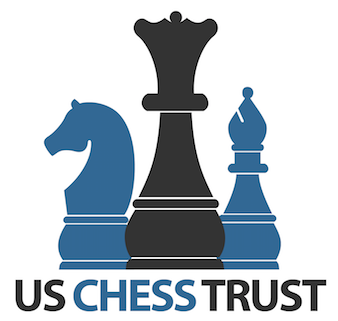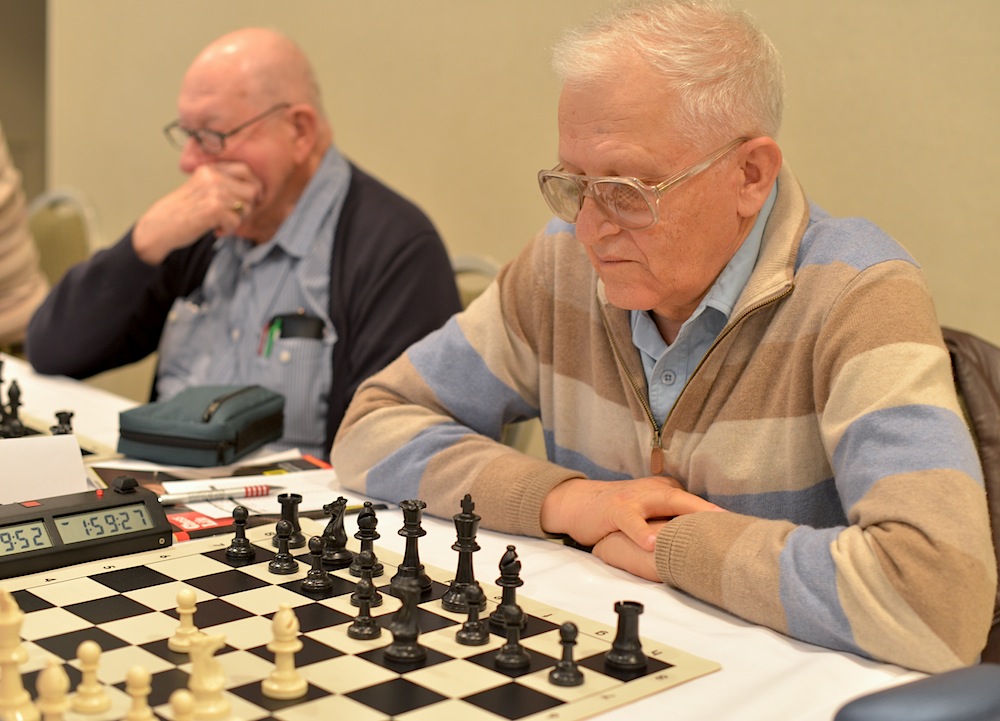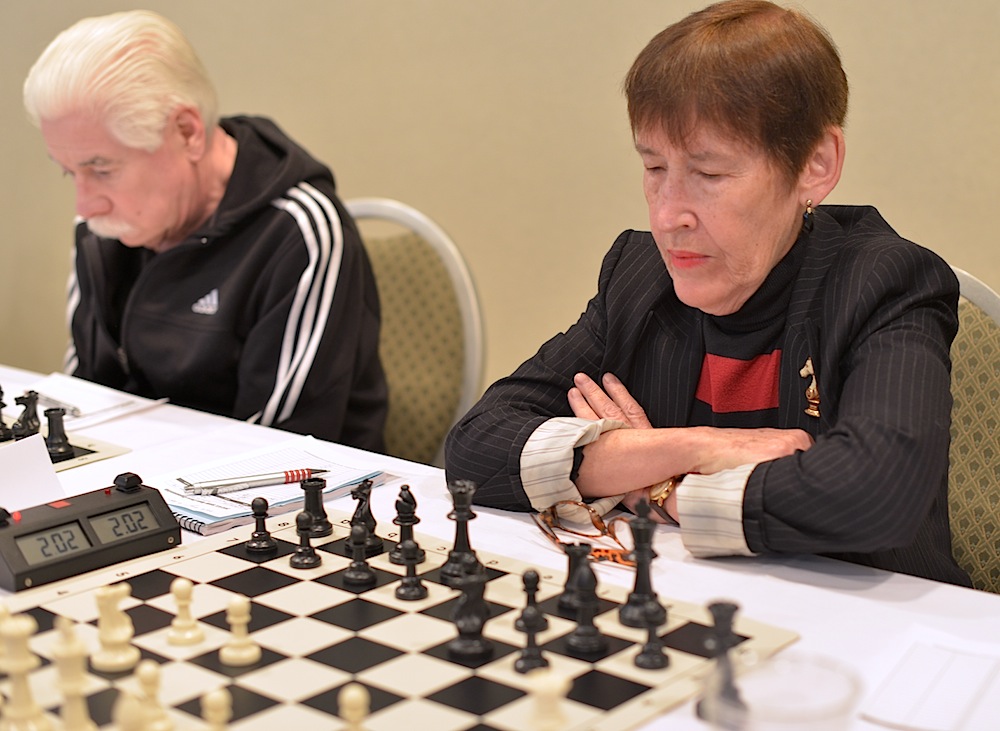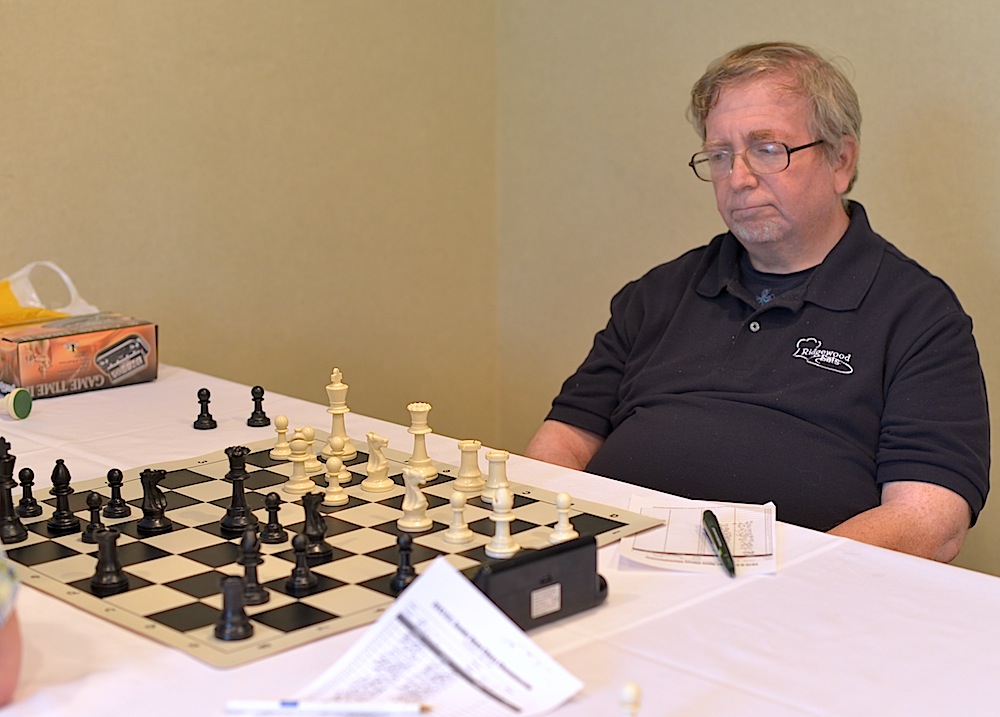GM Ivanov is U.S. Senior champion in 4 way tie
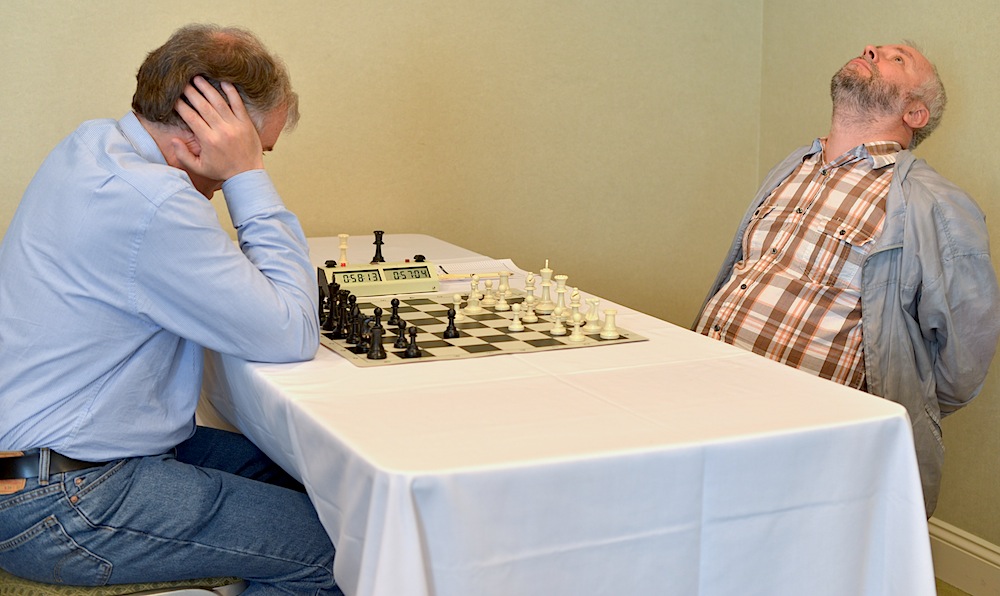

Article by Beatriz Marinello and Nathan Resika.
Photos by Dora Leticia ©
The U.S. Senior Open was held in Tarrytown, NY, from May 28th through June 2nd. The six round event drew a 57 player field including 2 Grandmasters, 2 International Masters, 3 FIDE Masters, 6 National Masters, and one Woman International Master. Players over 50 years old qualified for this event.
The Tournament ended in a 4-way tie for 1st place between GM Alexander Ivanov (Champion on tie-breaks), GM Sergey Kudrin, IM James Rizzitano, and FM Nathan Resika, who all scored 5 out of 6.
Since the under 2300 prize was greater than 4th prize and Resika was under 2300, the prize was bumped up and the 4 winners each recieved $800; while the 4th place prize was bumped down to IM Jay Bonin and FM Dan Shapiro (4.5/6) who each recieved $150.
The best player over age 60, Leonid Bondar (4/6), was awarded a $1,000 stipend to travel to Croatia to play in the World Senior Championship, which he has accepted. The U.S. Chess Trust is a proud supporter of this event and will provide a $500 stipend for the World Senior Championship and the USCF is also providing $500 stipend for a total of $1,000.
WIM Dolly Teasley found her form and took a share of the 2nd place prize (Under 2300) as well as the $350 best woman prize! (though, sadly, only 3 women participated in the event).
Ivanov’s wonderfully masterful preparation against IM Bonin showed he was a deserving champion. Below you will find games annotated by the 4 winners:
“After four rounds there were four players leading the tournament with three and a half points. The pairings for Rd 5 for the top two boards were: Ivanov 2641–Bonin 2405 and Kudrin 2580–Shapiro 2304. I realized I needed a win in order to fight for first since Sergey was going to be my last round opponent even in case of a draw in one of these games.” Alexander Ivanov
Ivanov/Bonin Round 5 /ANNOTATED GAME
1.e4 c5 2.Nf3 Nc6 3.d4 cxd4 4.Nxd4 e5 This came as no surprise. Kalashnikov has been Bonin’s favorite defense against 1.e4 for the last few years. 5.Nb5 d6 6.Be3 [After 6.N1c3 a6 7.Na3 b5 8.Nd5 White should be prepared for 8…Nge7 (or 8…Nce7 ) ] 6…Be6 7.N1c3 [7.Nd2!?] 7…a6 [7…Nf6] 8.Na3 Rc8 9.Nc4 Nd4 10.Bxd4 Bxc4 11.Bxc4 Rxc4 12.Be3 Be7 13.Qd3 Rc6 I was pretty sure we would reach this position since it had already occured in my opponent’s games a couple of times with good results for Black. Still, it doesn’t look like Black has equalised yet. 14.0–0 [14.0–0–0 Bg5 seemed less promising.] 14…Bg5 Played quickly. Black deviates from an earlier game I had seen in my preparation [14…h6 15.Nd5 Nf6 16.c4 0–0 17.f3 Nxd5 18.Qxd5 Bg5 19.Bf2 Qe7 20.Rad1 Rfc8 21.b3 h5 22.Rd3 h4 23.h3 Bf4 24.Rfd1 b5 25.cxb5 axb5 26.Qxb5 Rc2 27.Rxd6 Rxf2 28.Rc6 Rxc6 29.Qxc6 Be3 30.Qc8+ Kh7 31.Kh2 Qg5 32.Qg4 Rxa2 33.Rb1 Qf4+ 34.Kh1 Qxg4 35.hxg4 Kh6 36.Kh2 Kg5 37.Kh3 Kf4 38.b4 g5 39.b5 Bb6 40.Kh2 h3 41.Kxh3 Ra8 42.g3+ Kxf3 43.Rf1+ Bf2 0–1 Pruess,D (2424)-Bonin,J (2365)/ICC INT 2007/CBM 120 ext] 15.Bxg5 Qxg5 16.Nd5 Qd8?! After this I realised that 14…Bg5 was not a prepared move. Losing two tempi in such a position can hardly go unpunished. As it turned out my opponent missed that in the line [16…Nf6 17.Qb3 (17.f4!?) 17…Nxd5 18.Qxb7 was not possible due to 18…Ne7!] 17.Qg3!± [Less convincing is 17.Qb3 Qd7 18.Qg3 f6 planning Nh6] 17…g6 [17…Kf8 18.f4±] 18.Qb3 Qc8 19.f4 Rxc2 20.fxe5 Nh6 [On ‘normal’ 20…dxe5 I was going to play 21.Nc3 (21.Rad1!+- Houdini) 21…Qc5+ 22.Kh1 Rf2™ 23.Qxb7 Kf8 24.Qxa6 Kg7 25.Nd5+-] 21.Nf6+ Kf8 22.exd6 Kg7 23.Kh1 Rd8 24.Rad1 Black’s position is hopeless. The remaining move are simple: 24…b5 [24…Qc4 25.Qg3 Qe2 26.d7+-] 25.Qg3 Ng8 26.Qh4 h6 27.d7 Qa8 28.Nxg8 Kxg8 29.Qe7 f5 30.Rd6 Not falling into beginner’s trap[30.exf5?? Qxg2#] 1–0
Kudrin’s sparkling miniature against strong FM Shapiro drew gasps from onlookers.
KUDRIN – SHAPIRO ( Round 5)
Former US Junior Open Champ and now US Senior co-champ Jim Rizzitano shows us his entertaining tussle against dangerous Nuyorussian Master Yefim Treger.
“I walked into the tournament room on Thursday night and saw several players I had not played against in more than 30 years. I remember thinking “Is this what it all comes down to? Those 30 years sure went by quickly!”. The board 1 game Kudrin-Ivanov was a quick draw so I knew early on that a win would tie for first place.” – James Rizzitano
Rizzitano/Treger ANNOTATED Game
1.e4 g6 2.d4 Bg7 3.Nc3 a6!? [This is a very ambitious idea – the customary move is 3…d6 ] 4.f4 d5!? 5.e5 [The most principled move, establishing a large space advantage – Black is fine after 5.Nxd5 e6 6.Nc3 Qxd4 7.Qxd4 Bxd4 8.Nf3 Ba7 with equal chances.] 5…h5 [Black erects a blockade on the light squares – another idea is 5…Nh6!? ] 6.Be3 Nh6 7.Nf3 Bg4 8.h3 Bxf3 9.Qxf3 e6 10.g3! [The idea is to maintain the flexibility of White’s kingside pawn structure by denying Black the chance to play …h4. White must avoid 10.g4? Qh4+ 11.Bf2 hxg4 and Black is fine.] 10…Qe7!? [This is a novelty – an earlier game continued 10…Nc6 11.0–0–0 Nf5 12.Bf2 with a slight edge for White in Kryvoruchko-Chernyshov, Cappelle la Grande 2005.] 11.0–0–0 Nc6 12.g4! White has a clear advantage as Black’s pieces are bottled up on the kingside. 12…h4 13.Kb1 0–0–0 14.Na4!? Qb4 15.Nc5 Bf8 16.c3 Qb6 17.Bd3 Na5 18.Qe2? [White misses the chance to break through on the kingside with the direct 18.f5! gxf5 19.Bg5! Re8 20.Bf6! Bxc5 21.dxc5 Qxc5 22.g5 Rh7 23.gxh6 Rxh6 24.Bxf5 and White has a decisive advantage.] 18…Nc6 19.Nb3 a5 20.Nc5 Nb8 21.Rhf1 Nd7 22.Na4 Qa7 23.b3? [White dominates the board after the straightforward 23.c4! for example: 23…c6 (23…Nb6 24.Nxb6+ Qxb6 25.cxd5 exd5 (25…Rxd5 26.Bc4 wins.) 26.f5 with a crushing kingside pawn roller.) 24.cxd5 exd5 (or 24…cxd5 25.Qc2+ Kb8 26.Rc1 and White invades along the c-file.) 25.f5 and White wins.] 23…Nb6 24.Nc5 Nd7 25.Nxd7 Rxd7 26.f5 [Once again I miss the chance to play 26.c4! with a huge edge.] 26…gxf5 27.gxf5 Rd8 28.fxe6 fxe6 29.Rf6 Qb6 30.Rdf1 Bg7 31.Rg6 Rdg8 32.Rfg1 Bf8 33.Bxh6 [I missed several easier wins in the scramble leading up to the first time control at move 40 – easiest is 33.Rxg8! Rxg8 (33…Nxg8 34.Qf2 Ba3 35.Bc1 wins.) 34.Rxg8 Nxg8 35.Qh5 Qc6 36.Qf7 and White wins a piece.] 33…Rxg6 34.Rxg6 Bxh6 35.Qg4 [35.Qh5! Bg7 36.Qg4 wins.] 35…Kb8 36.Qh5? [Nothing wrong with the obvious 36.Rxe6 c6 37.Qxh4 Bg7 38.Qe7 Rxh3 39.Qxg7 Rxd3 40.Re8+ Ka7 41.Qf8 and White penetrates decisively.] 36…Bg7 37.Qg5 Qc6 38.Kc2 Rf8 39.Qxh4 Qd7 40.Qg3 Bh8 41.h4 c5 42.Kb2 Qf7 43.Bc2 Rc8 44.h5 a4 45.bxa4 cxd4 46.cxd4 Qc7 47.Qd3 47…Bxe5!? [Yefim sacrifices his bishop to obtain counterplay – passive resistance is hopeless after 47…Qb6+ 48.Bb3 Qc7 49.Qd2 Bxe5!? 50.dxe5 Qxe5+ 51.Ka3 Qxh5 52.Rxe6 and White has a decisive advantage.] 48.dxe5 Qxe5+ 49.Kb3! [White has to avoid some geometric tactics after 49.Kb1 Qe1+ 50.Bd1?? (50.Kb2! Qe5+ 51.Kb3! transposes to 49 Kb3!) 50…Qb4+ 51.Bb3 Qe1+ 52.Qd1 Qe4+ with a draw.] 49…d4 [Black runs out of tricks after 49…Qxh5 50.Rxe6 and White wins.] 50.Kb2 Rc3 51.Qb5 Qc7 [Yefim thought for several minutes here – no doubt he saw that after 51…Rc5 52.Qe8+ Ka7 (52…Rc8 53.Qxe6 Qxh5 54.Rf6 wins.) 53.Qxe6! (White must avoid 53.Rxe6?? Qg3! eyeing the c3-square.) 53…Qc7 54.Qe4 Rxh5 55.Qxd4+ Rc5 56.Rd6 White wins.] 52.Rg2 Rh3 I thought for roughly 10 minutes here calculating the decisive sequence – it seemed to me that White should have a way to break Black’s resistance. 53.Qb4! Qe5 54.Be4! The bishop sacrifice is the most precise way to end the game – it transpires that Black’s king is also exposed. 54…Qxe4 [No relief is offered by 54…d3+ 55.Qc3 Rxh5 (55…Qxe4 56.Rg8+ Ka7 57.Qa5#; 55…Qxc3+ 56.Kxc3 Rxh5 57.Rg7+-) 56.Rg8+ Ka7 57.Qxe5 Rxe5 58.Bxd3 and White will win the endgame – note that his bishop is the correct color for escorting the a-pawns to the eight rank.] 55.Qd6+ [55.Rg8+ also works.] 55…Ka7 56.Qc5+ White’s advanced doubled a-pawn decides the game. 56…Ka6 [Or 56…b6 57.Rg7+ Qb7 58.Rxb7+ Kxb7 59.Qe7+ Kb8 60.Qxe6 and White wins.] 57.Qb5+ Ka7 58.Qa5+ Kb8 59.Rg8# An exciting game! 1–0
Nathan Resika decribed his cute underpromotion in his final round game with Croatia bound Leonid Bondar as “not entirely necessary but definitely the simplest win.”
“My last round opponent had beaten 2 National Masters and drawn dangerous NuyoRussian master Yefim Treger. His opening innaccuracies on moves 12 and 20 gave me a healthy advantage. He also engaged in a policy of trading pieces, perhaps in hopes of a draw. However, my studies last year of Ulf Andersson’s games paid off as his 15th (Bxg2) and 19th (Bxb2) trades made White’s edge decisive. My under promotion on move 60 was not entirely neccessary, but was definitely the simplest win. It meant a lot for me to tie for 1st place in my first U.S. Senior Open championship. It was also an honor to share the prize equally with one of my first teachers, GM Alexander Ivanov, as well as two other New England legends, GM Kudrin and IM Rizzitano.” – Nathan Resika
2013 U.S. Senior Open Final Standings – Click Here for PDF >>>
